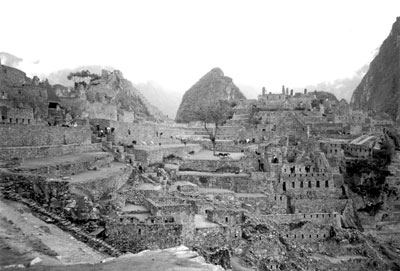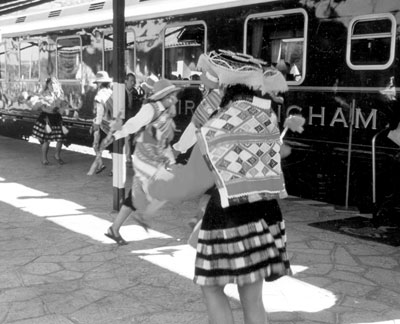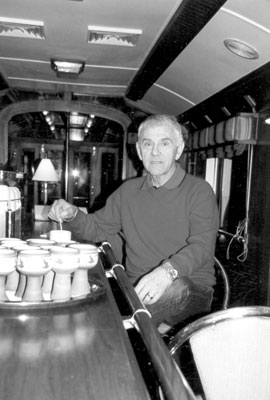Destination: Cuzco
by Deanna Palić
As a delegate to the Latin America Travel Mart in September ’05, I was invited by PeruRail to sample their luxury train, the Hiram Bingham, which links Cusco and Machu Picchu.
PeruRail is widely recognized as having not only one of the highest rail routes on Earth but the world’s most scenic railway service. Their service links most of the tourist highlights of the Peruvian Andes and is undoubtedly the most spectacular way to discover the ancient land of the Inca.
My husband and I arrived in Cusco directly from Los Angeles via LAN Peru. After a brief stop in Lima to clear Immigration and Customs, we boarded another LAN Peru flight to Cusco. It was a short, one-hour flight. Airport departure taxes in Peru are $6.05 on domestic flights and $30.25, international.
After collecting our luggage at the Cusco airport, we noticed that our hotel, the deluxe, 5-star Libertador Palacio del Inka Cusco, had a hospitality desk. We gave our names to the hostess and were offered courtesy transport to the hotel. When we made our reservations, we were not informed that this courtesy service was available to hotel guests.
For our double room, we were given a convention delegate discount off the regular rack rate of $240 plus 10% service for a single or double. A sumptuous breakfast buffet is included in the rate.
The hotel, which had tripled in size since my last stay, is located in the historical center of the city. The main entrance faces the impressive Korikancha, or Temple of the Sun, and is a short walk from the main square. The hotel’s original building, House of the Four Busts, dates back hundreds of years. Incan walls are still visible in the corridors, public lounges and main restaurant. During colonial times, it was used as a residence for nobility.
For reservations or additional hotel information, call 800/457-4000 or visit www.libertador.com.pe. (For a comprehensive description of hotels in Cusco, see the April ’02 issue, page 155.)
On this trip, the September weather was uncharacteristic for Cusco. September and October are normally the dry season, but we encountered considerable rain, with daytime temperatures in the 60s and evenings in the 50s. Weather patterns seem to have changed worldwide.
The Inca
The Inca represented the greatest civilization of South America, ultimately ruling an area that stretched from Ecuador south to Chile. Even though the Inca never had access to the wheel, they built an intricate system of roads paved with flat stones to connect their many cities.
As fierce warriors, the Inca conquered all around them. Their violence was not totally reserved for others. Convicted criminals had their hands cut off or their eyes gouged out, were hung up to starve to death or were simply tossed off cliffs. They even sacrificed their own to the gods, creating frozen mummies that still endure in the upper reaches of the Andes Mountains.
Cusco was the center of the Incan civilization, and it and Machu Picchu are perhaps South America’s most popular ancient destinations today. Machu Picchu, an 8,000-foot-high fortress built by the Incan king Pachacuti between 1460 and 1470, was the crown jewel of the Incan Empire. A special edition of the British magazine Wanderlust has published a list of “7 Wonders” in which the city of Machu Picchu once again placed at the summit of international tourism.
Machu Picchu, which some researchers believe was a royal resort, was occupied about 50 years before the Inca vanished. Its 200 structures of granite blocks are largely in tact. The granite was cut with bronze tools so that they fit perfectly together without mortar.
Train services for every budget
Some 43 miles from Cusco, Machu Picchu is reached by a 3-hour train ride. PeruRail has a variety of services: the deluxe Hiram Bingham, the Vistadome (first class) and the Backpacker. PeruRail’s 2006 rates for their Andean routes are noted in the accompanying chart.
| Route | Train | Round trip | One-way trip |
|---|---|---|---|
| Poroy-Machu Picchu-Poroy | Hiram Bingham | $495 | Not applicable |
| Cusco-Machu Picchu | Vistadome — snacks and hot and cold refreshments are included on the journey. | $105 | $59.50 |
| Cusco-Machu Picchu | Backpacker | $68 | $41.65 |
| Ollantaytambo-Machu Picchu | Vistadome | $71.50 | $41.65 |
| Ollantaytambo-Machu Picchu | Backpacker | $53 | Not applicable |
| Cusco-Lake Titicaca (and vice versa) | First class | Not applicable | $119 |
| Cusco-Lake Titicaca (and vice versa) | Backpacker | Not applicable | $17 |
For additional information, visit the website www.perurail.com. You also may refer to my article on the Vistadome in the March ’02 issue, page 168.
If you are one of the independent travelers who prefer to make their own arrangements, I would like to recommend the most excellent tour guide for Cusco and Machu Picchu that I have ever worked with: Julio Sotomayor (Saphy #726 [Interior #7], Cusco, Peru; tel. 51-84-438229). Julio, a native Cusceño, can guide you in saving money for all your Cusco arrangements.
When the explorer Hiram Bingham made his arduous mule trek 95 years ago, it was a much different scenario. Until that moment on July 23, 1911, Machu Picchu had been the Inca’s best-kept secret. The world was stunned by Hiram Bingham’s revelation.
PeruRail’s luxury Hiram Bingham train service follows those historic steps, and its coaches herald the crest of the man who might very well have been the first tourist to Machu Picchu. The coaches, reflecting the luxury of the 1920s’ Pullman era, were purchased in Singapore and refurbished in Peru. With a capacity of 84 passengers, the train has two dining cars, a bar car and a kitchen car.
The Hiram Bingham departs Cusco’s Poroy Station at 9 a.m., three hours later than the departures of the other services. The later departure not only presents a more leisurely morning but sets the train’s arrival at Machu Picchu at a time when other train passengers are almost ready to leave the sanctuary. We not only had the opportunity to experience our guided tour in relative solitude, we had a longer period of time there before the train’s 6 p.m. departure.
We enjoyed a light Continental breakfast after departure, followed by brunch prior to the 12:30 p.m. arrival in Machu Picchu. Once we were back on board, cocktails were served in the bar accompanied by live entertainment. Afterward, a 4-course, à la carte dinner was presented in the dining cars. The train pulled into Poroy Station in Cusco at 9:30 p.m. with everyone relaxed and ready for bed.
Included in the price of the ticket are the onboard meals, wine, beverages, live musical entertainment, tour guide, bus transfers to and from the citadel of Machu Picchu, entrance fees to the ruins and afternoon tea in the Machu Picchu Sanctuary Lodge. This charming Orient-Express property is located just steps from the entrance to the ruins.
Lodge rates of $825 single and $715 double include all meals and alcoholic/nonalcoholic beverages while the guest is registered at the hotel. For more information, call Orient-Express Hotels at 800/237-1236 or visit www.orient-express.com.
For me, Peru is the most interesting South American country. Gold, silver, alpaca and historic archaeological sites notwithstanding, Peruvian wealth is in the warmth of its people.
Coming up: cruising Latin America. . . European style!



